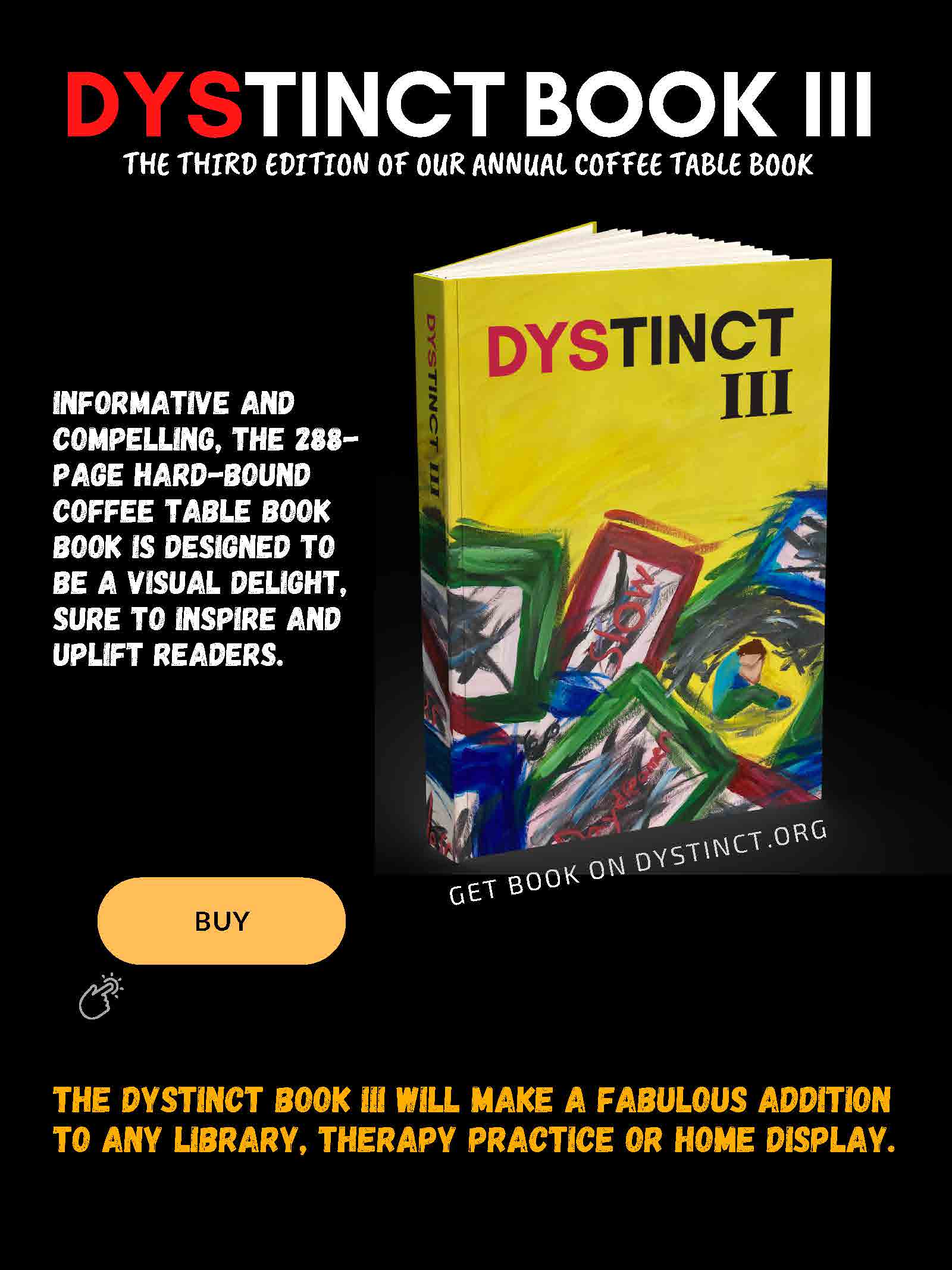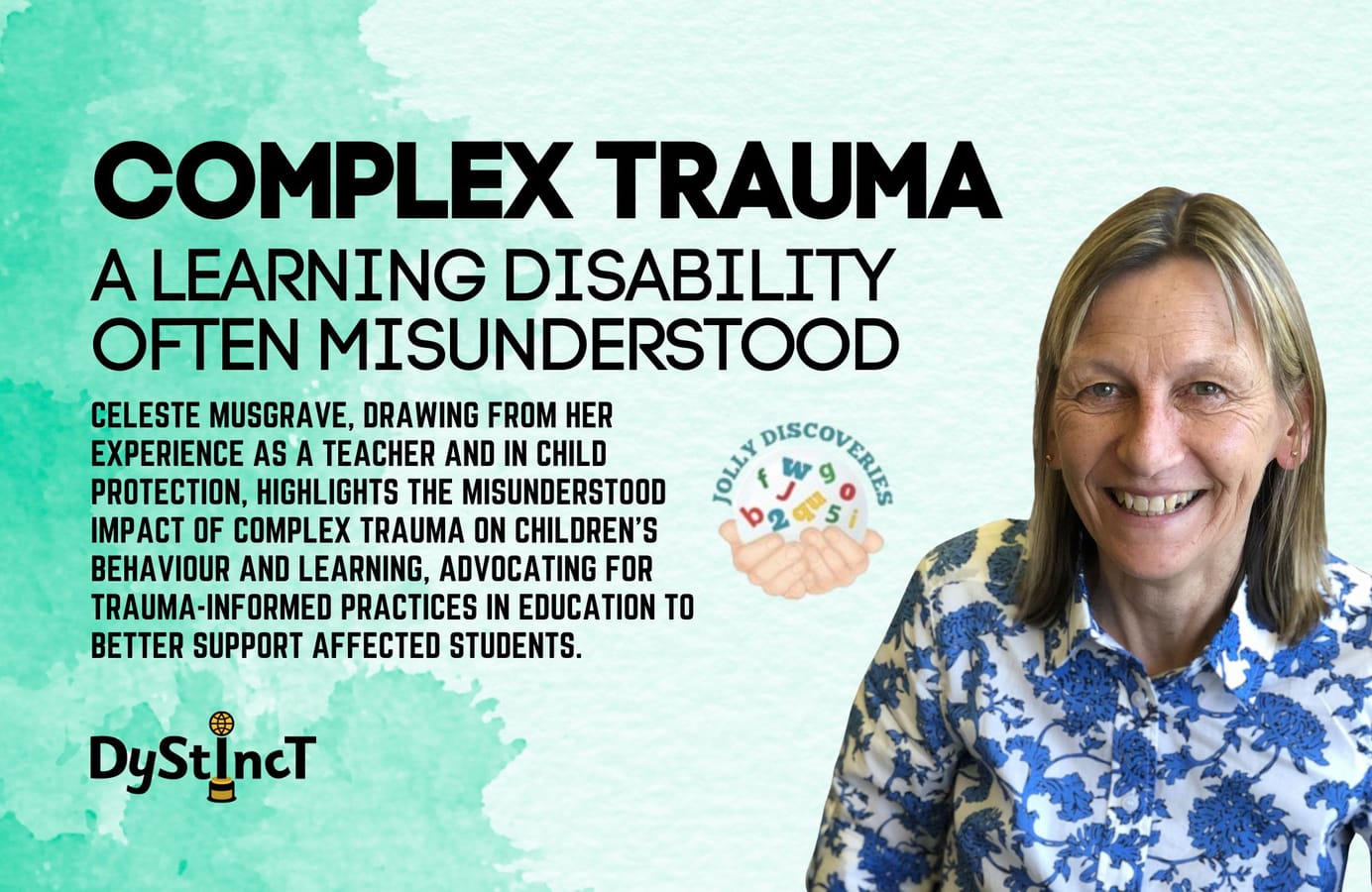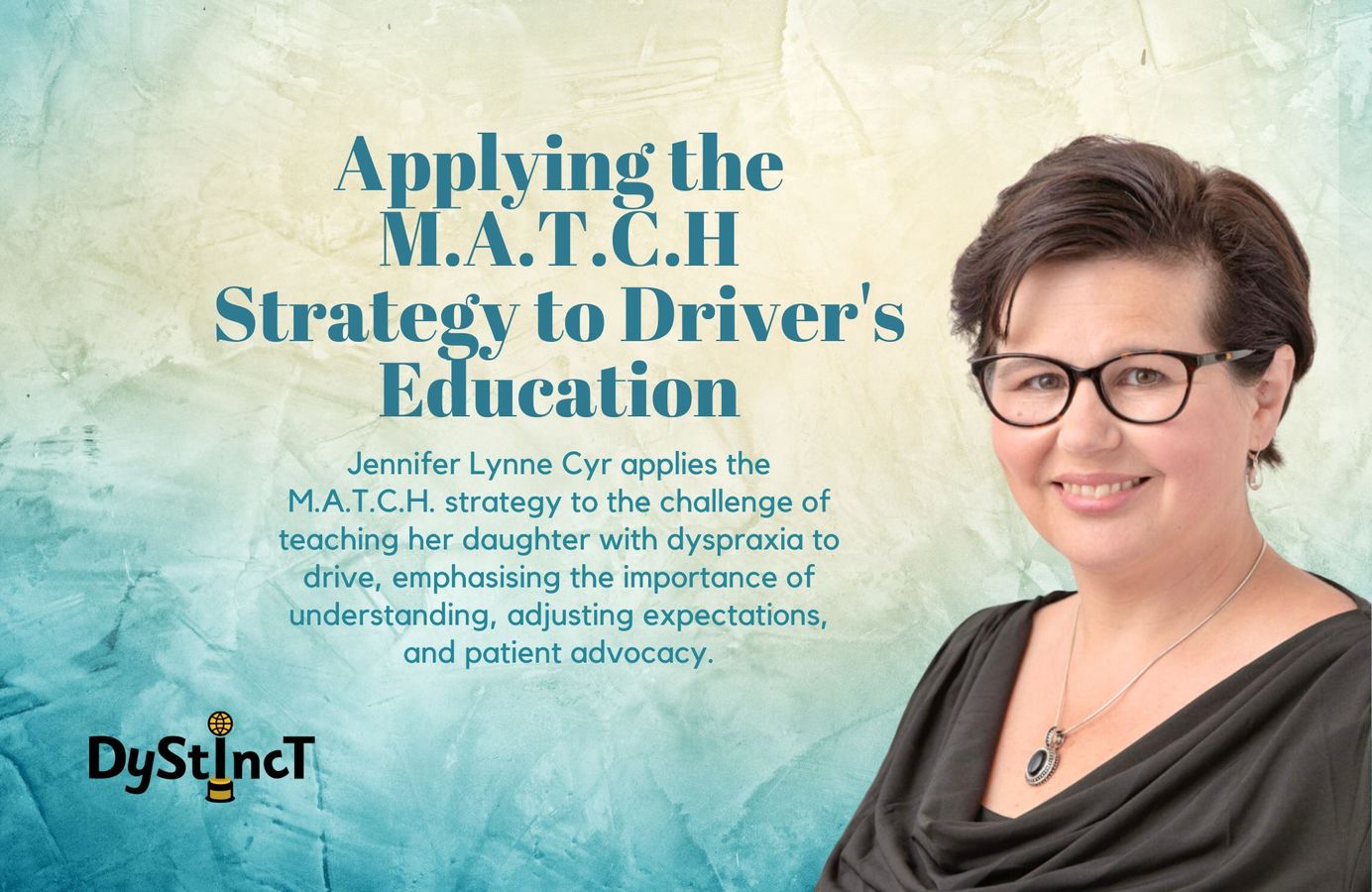
Issue 17: Applying the MATCH Strategy to Driver's Education | Jennifer Lynne Cyr
Jennifer Lynne Cyr applies the M.A.T.C.H. strategy to the challenge of teaching her daughter with dyspraxia to drive, emphasising the importance of understanding, adjusting expectations, and patient advocacy.
Table of Contents
When my daughter, Rachel, was first diagnosed with dyspraxia, the adults in her life had limited knowledge of the most effective ways to foster her success with physical tasks. Unfortunately, she didn't qualify for educational services that would have helped with her motor planning, penmanship, and math skills.
It was up to her father and me to figure out ways to strengthen her abilities. We are not neurologists, nor are we occupational therapists. The information we found on the internet in 2014 was not very helpful because we didn't know what we were searching for. Nearly a decade later, there is much more information available if you know to search for "Developmental Coordination Disorder."
My expertise is in literacy instruction. When a student struggles with reading, we target the student's specific needs and address deficits with direct, explicit, and systematic instruction. The good news is that there are excellent strategies that can be implemented to support students with Developmental Coordination Disorder. One framework that I discovered while perusing Dystinct Magazine is called M.A.T.C.H.
What is M.A.T.C.H?
What is MATCH?
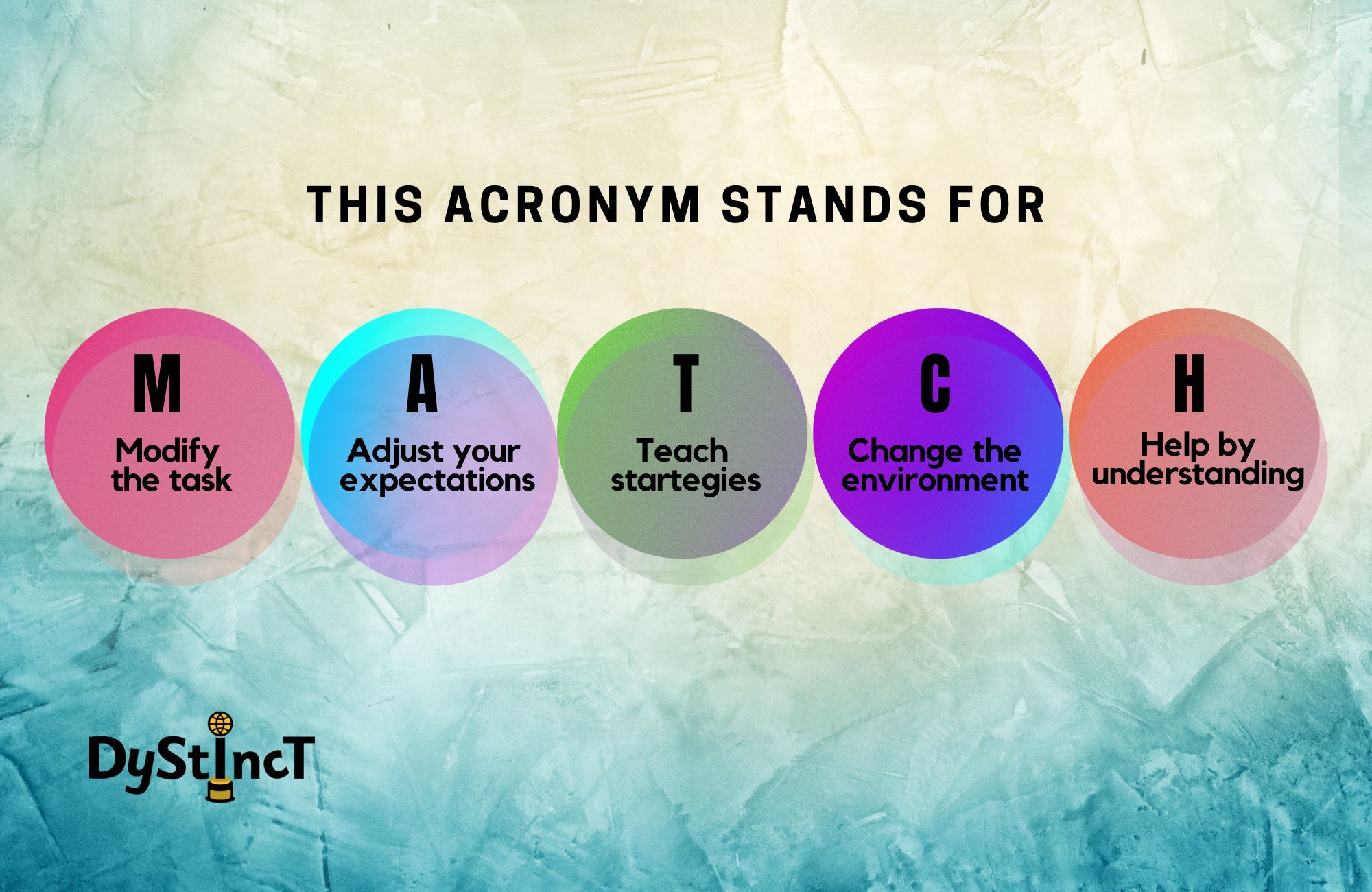
Wanting to try this strategy for myself, I reflected upon a parent-led instructional task. In the following section, I will attempt to apply M.A.T.C.H to the formidable goal of teaching my 17-year-old daughter how to drive.
MODIFY THE TASK
MODIFY THE TASK
This essentially means changing the thing you are asking them to do in a way that will predictably lead to success. Accommodations might fall under this category. In the classroom, modifying the task might look like paraphrasing the directions, providing visual information, providing assistive technology, or providing extra time to complete an assignment.
If the task is driving, most of us don't want to modify the vehicle. Rachel will need to learn to manage the car just like every other teen driver. There are, however, aspects of this task that are within our control. In the beginning, I adjusted her time on task by having her drive for 15 minutes before taking a break. The breaks allowed her to reflect on her recent driving and refresh her stamina for the next period. We switched from my husband's SUV to my vehicle, which has a backup camera for easier parallel parking and beeps when we get too close to another vehicle or obstacle. This reduced my verbal input. My verbal directions are very direct and precise. Recently, I've added GPS directions through Google Maps, which she will be able to use when I am not with her. I do not try to have casual conversations with Rachel while she is driving. When necessary, I coach her on the physical movements of driving, from pressure on the gas pedal to seating position, using the directional signals, and turning on the windshield wipers. We practice these until she demonstrates that she can apply them independently. Then, I stop coaching and switch to providing feedback following a task.
ADJUST YOUR EXPECTATIONS
ADJUST YOUR EXPECTATIONS
Simply put, instructors can consider alternate pathways to arrive at the same goal or outcome. How might Rachel become a safe, capable driver when she is reluctant to practice?
How will we reach 70 hours of driving time so that she can take her test? Adjusting one's expectations can lead a mom to question her motives. I would love for my daughter to reach milestones like driving when her peers do so that she can fit in and feel good about herself. It would be nice if my eldest child could give her sister a ride to the movies.
But let's be clear- this is what I want, not what my child needs. It was necessary for me to adjust my expectations for how Rachel was going to become a licensed driver. Maybe acquiring those 70 hours of practice will lead right up to Rachel's 18th birthday, when she could take the test without providing the practice time. Maybe I can reduce the pressure I put on her to practice more often so that driving is less stressful. While waiting for that license, perhaps her part-time job should be one that she can walk to. With this mindset, I made the decision to spread out our practice sessions so that we could recover and reflect in between. We drive regularly but have stopped thinking about finishing it all within a few months. While we are working on fluent and safe driving skills, I have had Rachel download Uber on her cell phone so that she can obtain a ride in an emergency. The end goal, if you think about it, is reliable transportation, and there is more than one pathway to that.
TEACH STRATEGIES
TEACH STRATEGIES
Students with DCD might be easily overwhelmed by tasks that require multiple steps. Teachers can break tasks down into smaller steps and guide students from step to step by modeling, coaching, providing feedback, and asking questions.
I'm experienced at scaffolding instruction:
"Put your hand on the turn signal. Push it up! Once you've changed lanes, push it back down."
I cannot forget about the gradual release of responsibility - where I backed off my verbal guidance and let her first describe her motions and then, eventually, simply drive without having to explain herself.
Students like my daughter might need the opportunity to verbalize and demonstrate the steps without the instructor dictating every little movement. The instructor can then provide feedback, which will resonate with students more than simply telling them what to do.
CHANGE THE ENVIRONMENT
CHANGE THE ENVIRONMENT
Sensory stimuli can make it hard for students with DCD to focus. The learning environment can be modified to reduce noise, light, and distractions like visual clutter, extra furniture, and overcrowded spaces. For example, in the very beginning, we drove in the expansive high school parking lot. It had no traffic, no observers, no traffic lights, and no distractions. The parking spots were well-marked, and there was room for parallel parking. As she developed skills in steering, braking, and staying in her lane, we spent more time in public spaces. We drove on long country roads with few stop signs and little traffic. As she improved in skill, we moved on to more congested roads with more obstacles. Rachel and I have different tastes in music. When she is driving, she gets to choose the soundtrack. This soothes her because singing along gives her an outlet for her anxiety.
HELP BY UNDERSTANDING
HELP BY UNDERSTANDING
This item comes down to advocacy. First, the student's caregivers can communicate with adults in the student's educational community about their child's strengths, interests, obstacles, and effective strategies for meeting their needs. Ideally, the student will grow to advocate for themselves. You can facilitate this by giving them opportunities to lead discussions, vocalize their thoughts, and describe their processes for accomplishing tasks.
LEARNING TO DRIVE
LEARNING TO DRIVE
Learning to drive is hard for Rachel. I understand this, and I show respect for her efforts. I provide guidance, opportunities for practice, and a safe, open road for practice. I keep myself calm. I don't overreact to small errors. I avoid pressuring her to make speedy progress. I let her take control and establish her parameters for learning. If and when she needs me to step in and take the wheel, I am there for her.
The M.A.T.C.H. framework can be applied to many of the situations that our children with dyspraxia/DCD will encounter. Using this tool will help parents to improve their understanding and advocate for their beloved charges.
Key Factors
Key Factors
Dr. Angela Webb wrote an article about DCD for Dystinct back in March, 2021. In her conclusion, she stated that in working with patients with DCD, "the greatest successes hinge on four key factors." I thought it important to restate these factors here.
- CORRECT DIAGNOSIS
Due to the frequency of comorbidities and symptoms that overlap with other conditions, diagnosis by a clinical psychologist or pediatric neurologist, with input from a physical therapist, will help provide the information you need to advocate for your child. Seek this information as early as possible. *Note: In some parts of the USA, DCD is not well understood, so finding a clinician who recognizes and understands DCD is critical. - THERAPEUTIC INTERVENTION
Physical therapy or occupational therapy can help your child to navigate everyday tasks. - SUPPORTIVE EDUCATIONAL ENVIRONMENT
Help teachers to understand the challenges of the condition and seek resources and accommodations that will help your child in the classroom. I am a fan of Universal Design for Learning, where any student, regardless of education plan, can access certain accommodations as needed. An example of this is assistive technology, which will help many students to communicate in writing even if their handwriting skills are lacking. - MEDITATIVE PARENTING
The knowledge that parents must "Understand, accept, and support throughout childhood and adolescence." We act as mediators between the young person and the world and help with communication, suggest interventions, and model positive advocacy. (Webb, 2021)
Reading and References
Reading and References
Reading
- elearningcanchild.ca provides great explanations and examples of support for students with DCD.
References
- Webb, Angela. (2021) Dyspraxia/Developmental Coordination Disorder: What we know and what we can do. Dystinct Magazine. PP 66-80.
Jennifer Lynne Cyr
Jennifer Lynne Cyr
Jennifer Lynne Cyr is a school reading specialist and consultant. Her daughter, Rachel, is a senior in high school with many gifts and talents. Driving is not yet one of them.
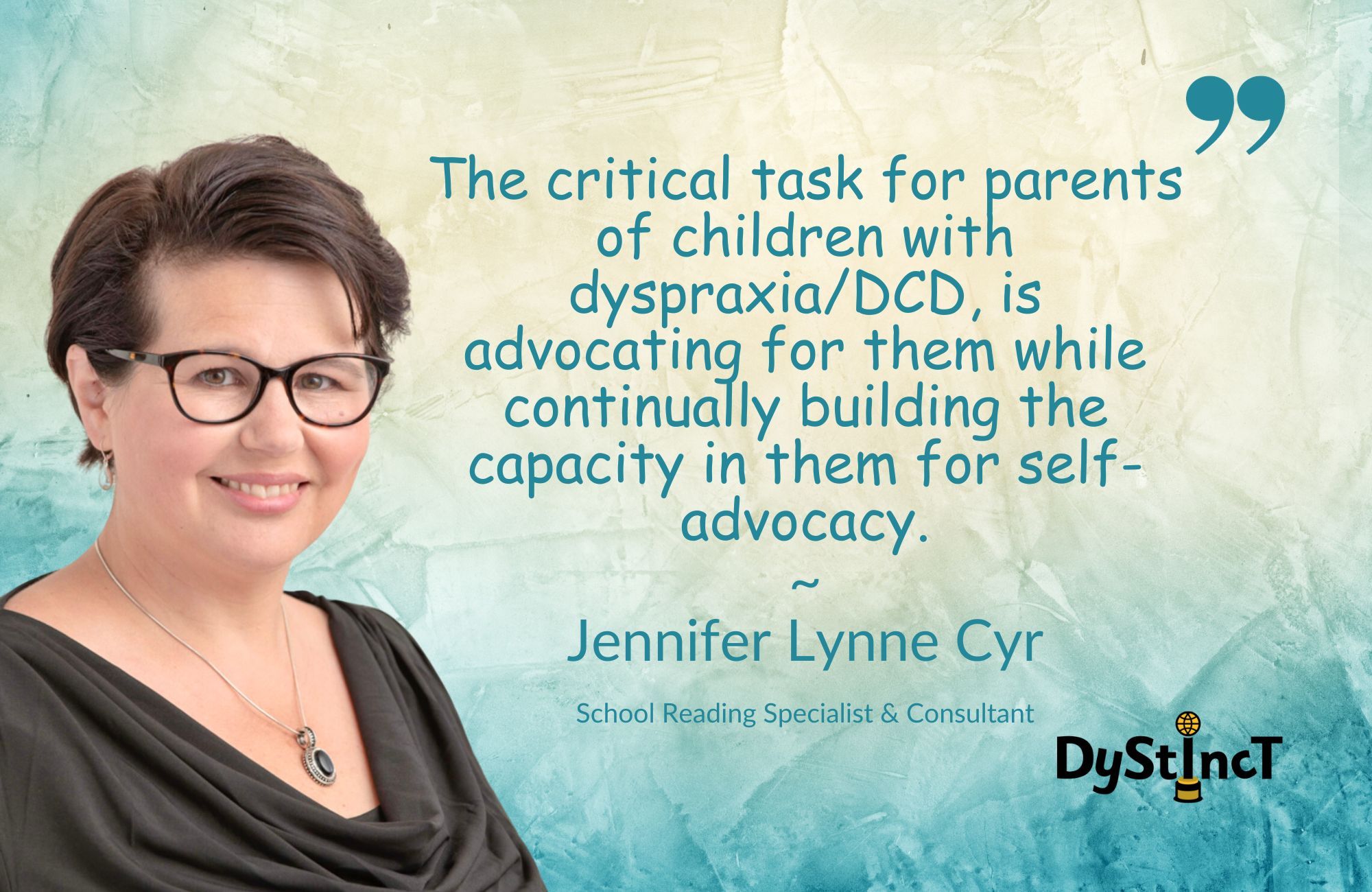
Extracts from Dystinct Magazine
Extracts from Dystinct Magazine











